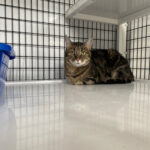Good cat owners are always looking for the best ways to ensure their feline companions live long, healthy lives. Nutrition plays a vital role in this, and many pet parents wonder if adding vegetables to their cat’s diet is beneficial. Beyond their regular cat food, what other foods can cats safely consume? Let’s delve into the question: Can Cats Eat Vegetables, and are they a healthy addition to your cat’s meal plan?
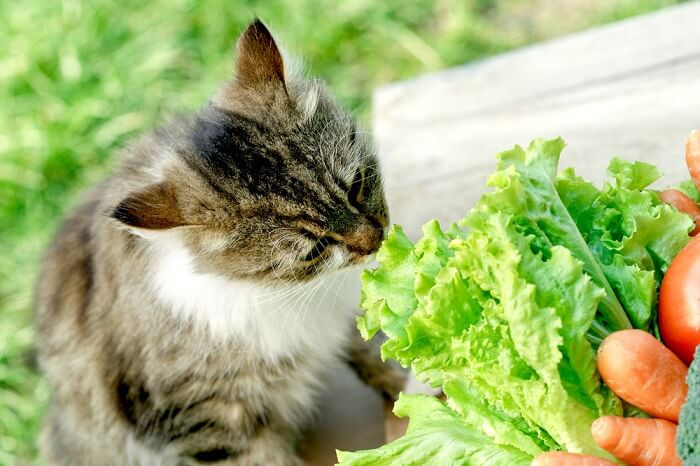 A cat curiously looking at a bowl of mixed vegetables, showcasing a potential interest in plant-based foods for felines.
A cat curiously looking at a bowl of mixed vegetables, showcasing a potential interest in plant-based foods for felines.
Are Vegetables Safe for Cats?
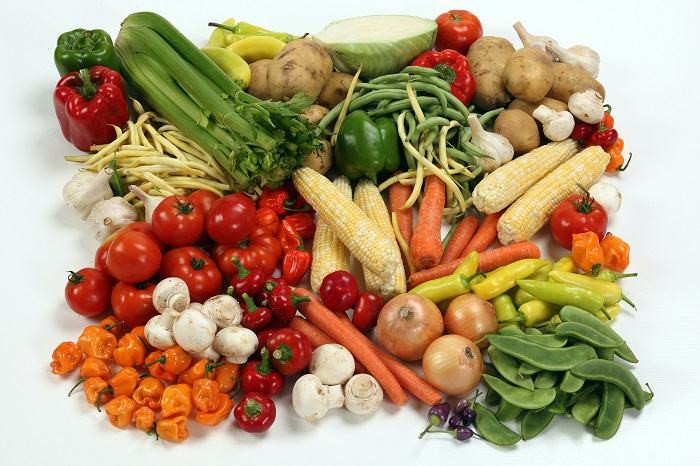 A colorful assortment of fresh vegetables, representing the variety of plant-based options that might be considered for a cat's diet.
A colorful assortment of fresh vegetables, representing the variety of plant-based options that might be considered for a cat's diet.
The short answer is yes, cats can eat some vegetables, but there are important considerations. While vegetables can be a safe and even healthy supplement to your cat’s diet, it’s crucial to choose the right kinds and prepare them properly. Think of cooked carrots or steamed broccoli as occasional treats, but steer clear of dangerous vegetables like onions and garlic, which are toxic to cats and can cause severe health issues.
It’s vital to remember that cats are obligate carnivores. This means their primary nutritional needs are met through a meat-based diet. The protein derived from meat is essential for their survival and overall health. Vegetables should never replace meat in a cat’s diet. Always consult with your veterinarian before introducing any new foods, including vegetables, to your cat’s meal plan. They can provide personalized advice based on your cat’s specific health needs.
Vegetables Cats Can Eat Safely
Certain vegetables are not only safe for cats but can also offer some health benefits when given in moderation. Here are some good options:
1. Broccoli
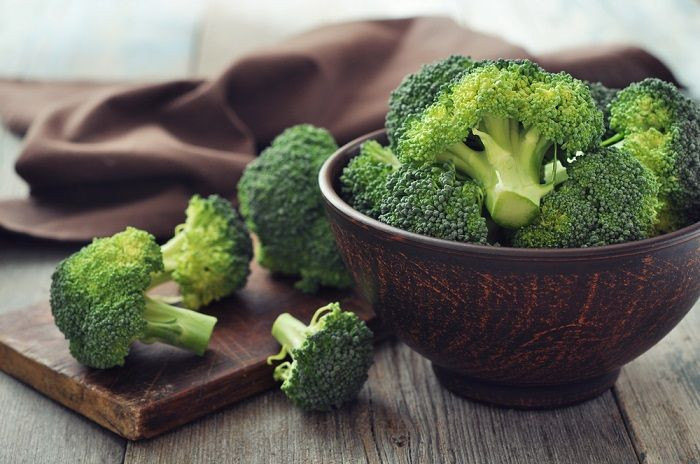 A close-up of broccoli florets, highlighting the texture and nutritional value of this cat-safe vegetable.
A close-up of broccoli florets, highlighting the texture and nutritional value of this cat-safe vegetable.
Broccoli is a feline-friendly vegetable that’s easy to prepare and packed with antioxidants. Antioxidants help protect cells from damage, contributing to overall health. Furthermore, broccoli is a good source of dietary fiber, which aids in healthy digestion and regular bowel movements. A little bit of steamed or cooked broccoli can be a beneficial addition to your cat’s diet as an occasional treat.
2. Carrots
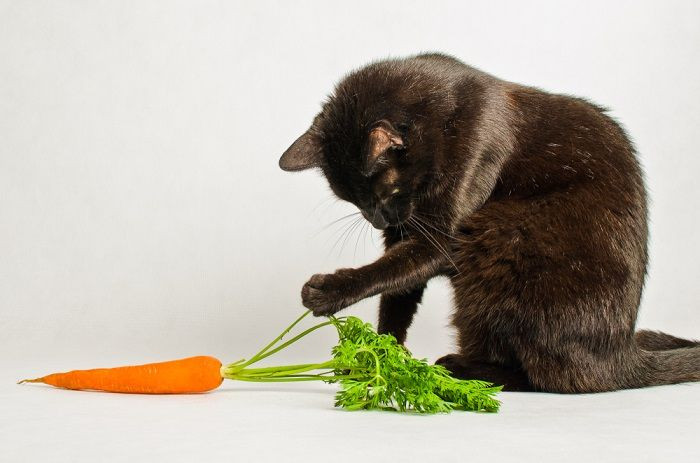 A cat playfully interacting with a carrot, suggesting the palatability and safe nature of carrots for feline consumption.
A cat playfully interacting with a carrot, suggesting the palatability and safe nature of carrots for feline consumption.
Carrots are another safe and nutritious vegetable for cats, offering a good dose of vitamins and minerals. They are particularly rich in vitamin A, a crucial vitamin for maintaining good vision, a healthy immune system, and proper organ function in cats. Carrots can be offered as a crunchy snack, but remember moderation is key due to their oxalate content. Cats with a history of calcium oxalate bladder stones or urinary crystals should have carrots limited in their diet.
Cooking carrots, whether by steaming or boiling, is recommended to soften them and reduce the risk of choking, especially for enthusiastic eaters. While raw carrots aren’t toxic, cooked carrots are easier to digest and safer for your feline friend.
Read More: Can Cats Eat Carrots?
3. Green Beans
 Fresh green beans, showcasing their vibrant color and fiber-rich composition, ideal for feline digestive health.
Fresh green beans, showcasing their vibrant color and fiber-rich composition, ideal for feline digestive health.
Many green vegetables are safe for cats and can contribute positively to a balanced diet. Peas and green beans are excellent examples. Fresh or frozen green beans, when cooked, offer various health benefits. If you choose canned green beans, opt for low-sodium varieties as excessive sodium is detrimental to feline health.
Green beans stand out as particularly beneficial due to their high fiber content. Fiber is essential for a healthy digestive system and can also play a role in weight management for cats. Similar to carrots, green beans contain moderate levels of oxalates, so portion control is important, especially for cats prone to bladder issues.
4. Spinach
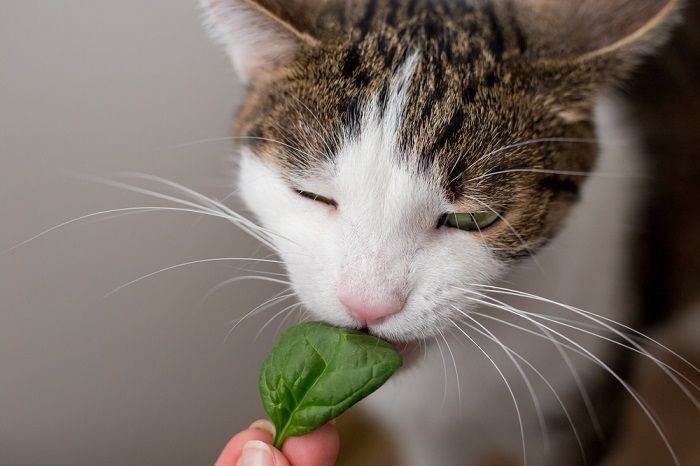 A cat near fresh spinach leaves, indicating potential interest in this leafy green, while highlighting the importance of moderation.
A cat near fresh spinach leaves, indicating potential interest in this leafy green, while highlighting the importance of moderation.
Spinach is another vegetable that provides cats with vitamins and minerals. Some believe it may also possess anti-inflammatory properties, which could be beneficial for cats with inflammatory conditions. However, spinach should always be given sparingly due to its calcium oxalate content. While small amounts are generally harmless, larger quantities can contribute to urinary tract problems in susceptible cats. Moderation is key when offering spinach to your feline companion.
5. Apples (Without Seeds and Core)
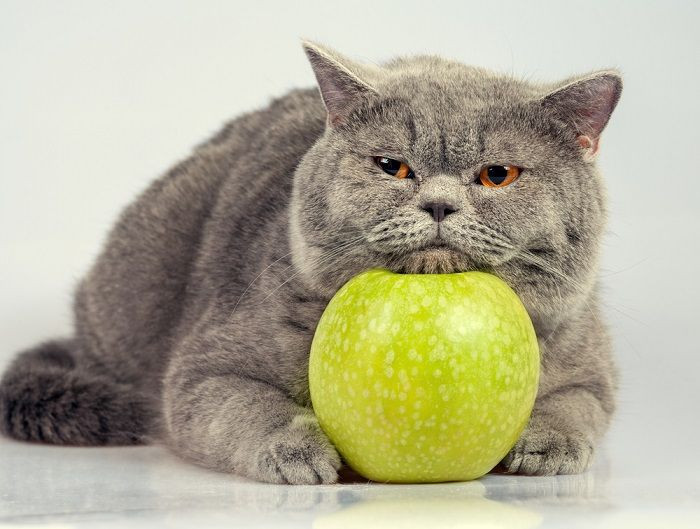 A cat sniffing an apple slice, demonstrating that some cats might find the taste of apples appealing, while emphasizing seed removal.
A cat sniffing an apple slice, demonstrating that some cats might find the taste of apples appealing, while emphasizing seed removal.
Yes, cats can eat apples in small amounts, but with specific preparation. Apples are generally safe for cats, although many cats may not be attracted to their taste. The notion that cats, being obligate carnivores, cannot digest apples is incorrect. While their primary nutritional needs are met by meat, cats can still digest and process plant-based foods like apples.
However, it’s crucial to remove the seeds and core of the apple, as apple seeds contain cyanide and are toxic. Apple flesh, in moderation, can be an occasional treat. Apples are relatively high in sugar, so they should be avoided for cats with diabetes as they can disrupt blood sugar levels. Similarly, cats with IBD, sensitivities, or chronic gastroenteritis may react negatively to apples. The fiber in apples can be difficult to digest for some cats, potentially causing gas, stomach upset, and diarrhea. Introduce apples cautiously and in small amounts, observing your cat for any adverse reactions.
Potential Downsides of Feeding Vegetables to Cats
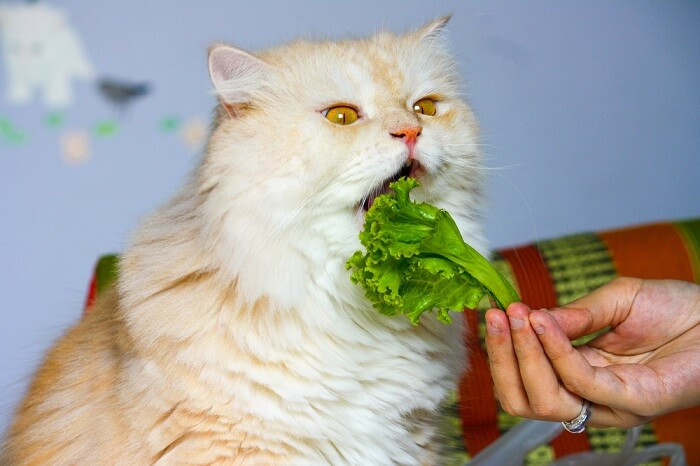 A cat looking away from a plate of lettuce, suggesting that cats might not always be enthusiastic about eating vegetables.
A cat looking away from a plate of lettuce, suggesting that cats might not always be enthusiastic about eating vegetables.
While some vegetables are safe and can offer benefits, there are potential negatives to consider when including them in your cat’s diet. Most of these issues arise from feeding too many vegetables or offering the wrong types.
As obligate carnivores, cats have a digestive system primarily designed to process meat. They lack sufficient digestive enzymes to efficiently break down large amounts of plant fiber. Consequently, feeding your cat too many vegetables can lead to digestive upset, including vomiting or diarrhea.
While vegetables contain fiber, which can be beneficial in small amounts, they also contain carbohydrates. Excessive carbohydrate intake can contribute to feline obesity, a growing health concern in cats. Therefore, vegetables should always be given in limited quantities to avoid contributing to weight gain.
Generally, most cooked and properly prepared vegetables are considered safe for cats in small amounts. However, certain vegetables are hazardous and must be strictly avoided due to toxicity or digestive difficulties.
Vegetables to absolutely avoid include:
- Onions
- Garlic
- Tomatoes (specifically unripe tomatoes, leaves, and stems)
- Chives
- Leeks
- Avocados
Dangerous Vegetables for Cats: What to Avoid
1. Onions, Chives, and Garlic
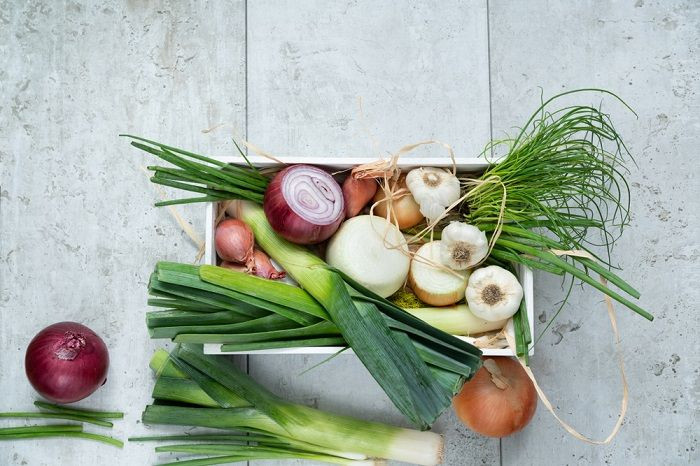 A collection of onions, chives, and garlic, visually representing the Allium family vegetables that are toxic to cats.
A collection of onions, chives, and garlic, visually representing the Allium family vegetables that are toxic to cats.
Members of the Allium family, including onions, chives, garlic, and leeks, are highly toxic to cats. These vegetables contain sulfur-containing oxidants that cats cannot properly break down. These compounds damage red blood cells, leading to hemolysis, where the cat’s body destroys its own red blood cells, potentially causing life-threatening anemia.
These vegetables are toxic in any form – raw, cooked, or powdered. Even small amounts can cause damage. The severity of the toxicity depends on the amount consumed and the concentration of toxic compounds, with garlic being the most potent in this group. Symptoms of Allium toxicity include vomiting, diarrhea, lethargy or fatigue, rapid breathing, pale or yellowish gums, and reddish or brownish urine. If you suspect your cat has ingested any of these vegetables, seek immediate veterinary attention.
2. Unripe Tomatoes, Tomato Plants
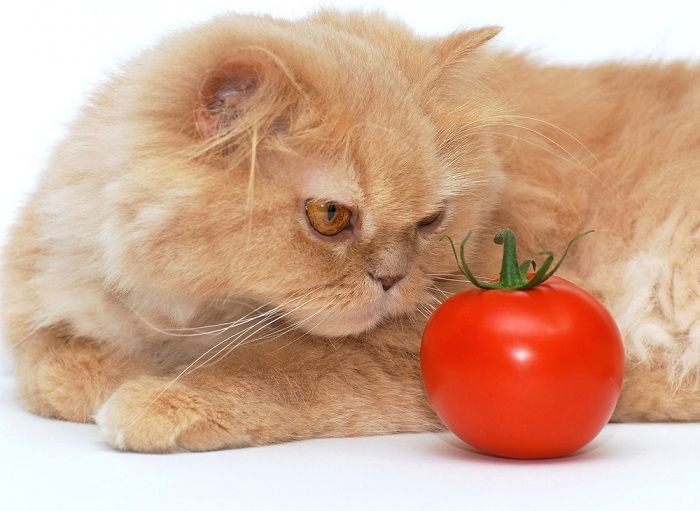 A tomato and a cat, with emphasis on ripe tomatoes being less problematic than unripe ones and other parts of the plant.
A tomato and a cat, with emphasis on ripe tomatoes being less problematic than unripe ones and other parts of the plant.
While ripe tomatoes on their own are generally considered non-toxic to cats in small amounts, the green parts of the tomato plant, including leaves and stems, as well as unripe green tomatoes, are toxic. These parts contain solanine, which can cause gastrointestinal upset in cats. Unripe tomatoes can also lead to similar issues. It’s best to avoid giving your cat any part of the tomato plant other than a very small piece of ripe tomato flesh, and even ripe tomatoes offer no nutritional benefit to cats.
3. Avocados
 A cat near avocados, visually representing the fruit that, despite being healthy for humans, poses health risks to cats.
A cat near avocados, visually representing the fruit that, despite being healthy for humans, poses health risks to cats.
Avocados, while a healthy and trendy food for humans, can cause problems for cats. Avocados have a very high fat content, which can be too rich for cats and may lead to gastrointestinal upset, vomiting, and diarrhea. Additionally, the pit and skin of avocados contain persin, which is mildly toxic to cats and can cause vomiting and diarrhea. The large seed also presents a choking hazard or potential intestinal obstruction if swallowed.
Read More: Pancreatitis in Cats: Causes, Symptoms, & Treatment (Pancreatitis can be triggered by high-fat foods like avocado)
The Benefits of Vegetables for Cats
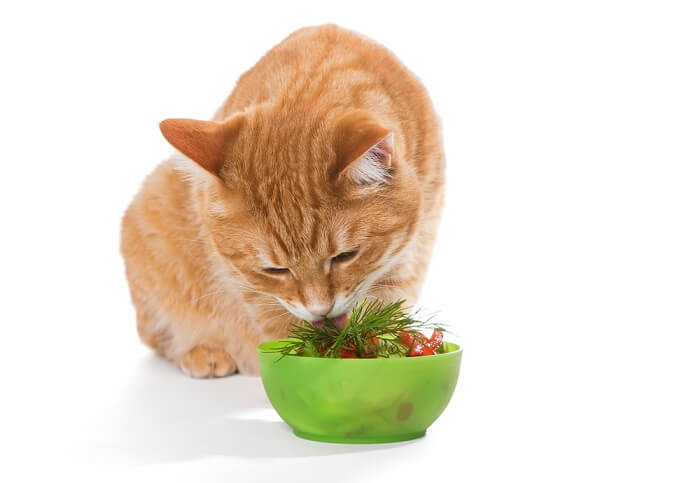 A cat enjoying a small salad, visually representing the idea of vegetables as a supplemental and potentially enjoyable part of a cat's diet.
A cat enjoying a small salad, visually representing the idea of vegetables as a supplemental and potentially enjoyable part of a cat's diet.
Even though vegetables aren’t a necessary component of a feline diet, they can offer some nutritional advantages when given in moderation and as part of a balanced feeding plan.
Remember, vegetables should never be the foundation of a cat’s diet. However, as supplemental treats, they can provide some beneficial nutrients. Cats cannot thrive on a purely vegetable diet.
In general, cats can safely eat many types of vegetables in small quantities. Some cats might even enjoy the variety and added texture vegetables bring to their diet. As a general guideline, treats and supplements, including vegetables, should constitute no more than 10% of your cat’s daily calorie intake. Vegetables contain valuable nutrients such as magnesium, potassium, fiber, vitamins, and antioxidants. These nutrients can contribute to boosting your cat’s immune system and promoting healthy digestion.
Vegetables can serve as a low-calorie alternative to commercially produced cat treats, which are often higher in calories and less nutritionally dense. However, always consult your veterinarian before making significant dietary changes for your cat, including adding vegetables. Your vet can provide personalized advice based on your cat’s individual health needs and dietary requirements.
When choosing vegetables for your cat, always prioritize safety and nutritional value. Stick to the safe vegetables listed earlier and avoid toxic ones.
Conclusion: Vegetables as Occasional Treats for Cats
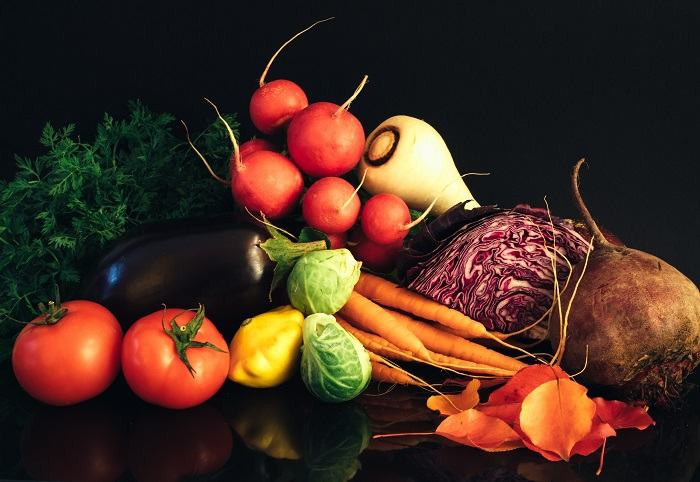 A cat looking content after eating, possibly implying the satisfaction of a balanced diet that might include small amounts of vegetables.
A cat looking content after eating, possibly implying the satisfaction of a balanced diet that might include small amounts of vegetables.
In summary, most non-toxic vegetables are safe for cats in small amounts and should be given only as occasional treats, not as a staple food. A cat’s diet should primarily consist of high-quality cat food formulated to meet their obligate carnivore nutritional needs.
Always consult with your veterinarian before introducing any new vegetables to your cat’s diet. Pay close attention to how your cat reacts to new foods. If you notice any signs of digestive upset or illness after your cat eats vegetables, stop offering them and seek veterinary advice.
Frequently Asked Questions About Cats and Vegetables
How much vegetable can I give my cat?
If you decide to offer your cat vegetables, prepare them by baking or steaming until soft and cut them into small, bite-sized pieces to prevent choking hazards. You can offer vegetables plain or puree them and mix a small amount into their regular cat food.
Remember that at least 90% of your cat’s daily calories should come from a complete and balanced, high-quality cat food. Treats, including vegetables, should make up no more than 10% of their daily calorie intake.
Are vegetables good for cats?
Cats do not have a biological requirement for vegetables in their diet. However, many vegetables are safe for them to eat in small quantities and can offer some supplementary vitamins, minerals, and fiber. Vegetables should not be considered a major part of a cat’s diet. To ensure your cat receives all the necessary nutrients, prioritize feeding them a high-quality, meat-based cat food formulated for their life stage and health needs.
Can cats eat vegetables every day?
It is not necessary and generally not recommended to give your cat vegetables every day. Vegetables are best offered a few times a week as an occasional treat to add variety and potential minor nutritional benefits.
Exceeding the 10% limit for treats (including vegetables) can lead to an imbalance in your cat’s diet, potentially causing them to consume too many carbohydrates and not enough of the essential nutrients they need from meat protein. This imbalance can contribute to health problems like obesity.
Can I give my cat too much vegetable?
Yes, overfeeding any food, including vegetables, can potentially make your cat sick. Excessive vegetable consumption can cause digestive upset due to their high fiber content and the cat’s limited ability to digest plant matter. Therefore, it’s best to offer vegetables only as an occasional treat in small amounts.


